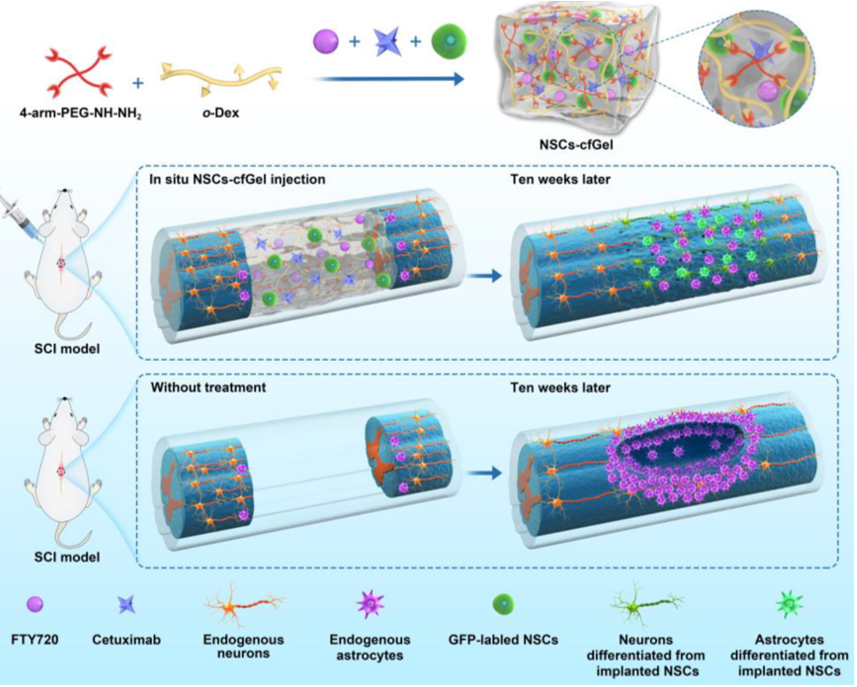
Chemical Engineering Journal 427 (2022) 130906
神经元丢失和胶质瘢痕形成是严重脊髓损伤(SCI)后阻碍轴突再生和神经再生的主要病理事件。严重脊髓损伤后,可能需要包括细胞移植和减少胶质瘢痕形成在内的治疗方法来实现实质性的功能恢复。近日,吉林大学第二医院两位教授设计了一种双药增强的可注射水凝胶,并将其与神经干细胞(NSCs-cfGel)结合,以促进大鼠脊髓全横断损伤模型的组织再生。通过可逆腙键交联制得可注射水凝胶,并对其力学性能和体内降解能力进行了分析。当与西妥昔单抗和FTY720两种药物联合使用时,该可注射水凝胶可促进NSCs的增殖和神经元分化,并抑制NSCs的星形胶质细胞分化。NSCs-cfGels移植到大鼠全横断脊髓损伤模型后,不仅能显著促进移植的NSCs的神经元分化和整合,而且能抑制胶质瘢痕的形成,促进轴突再生和神经回路重建。因此,接受NSCs-cfGel植入的脊髓损伤大鼠表现出最佳的功能改善。综上所述,本研究展示了一种具有应用前景的外源性神经干细胞双药增强型注射水凝胶,从而为脊髓损伤的综合治疗提供了一种新的策略。
Neuronal loss and the formation of glial scars are major pathological events that hinder axonal regrowth and neural regeneration after severe spinal cord injury (SCI). Therapeutic therapies that include both cell transplantation and reducing glial scarring is likely required to achieve substantial functional recovery after severe SCI.Recently, a dual-drug enhanced injectable hydrogel was designed and combined with neural stem cells (NSCs-cfGel) to enhance tissue regeneration in a rat complete transected SCI model by three professors from the second hospital of Jilin University. The injectable hydrogel was crosslinked by reversible hydrazone bonds, and the mechanical properties and degradation abilities were analyzed both in vitro and in vivo. When incorporated with two drugs (cetuximab and FTY720), the injectable hydrogel improved both the proliferation and neuronal differentiation and exhibited inhibitory astrocytic differentiation of NSCs in vitro. After transplantation into a rat complete transected SCI model, NSCs-cfGels not only significantly enhanced neuronal differentiation and integration of the grafted NSCs, but also inhibited glial scar formation, and promoted axonal regeneration and nerve circuit reconstruction. Consequently, SCI rats that received NSCs-cfGel implantation exhibited optimal functional improvement. Taken together, this study demonstrates a promising dual-drug enhanced injectable hydrogel for exogenous NSC delivery and thus provides a novel strategy for combination therapy of SCI.
Z. Qi, T. Zhang, W. Kong, C. Fu, Y. Chang, H. Li, X. Yang, S. Pan, Chemical Engineering Journal 2022, 427, 130906.
贠智赫